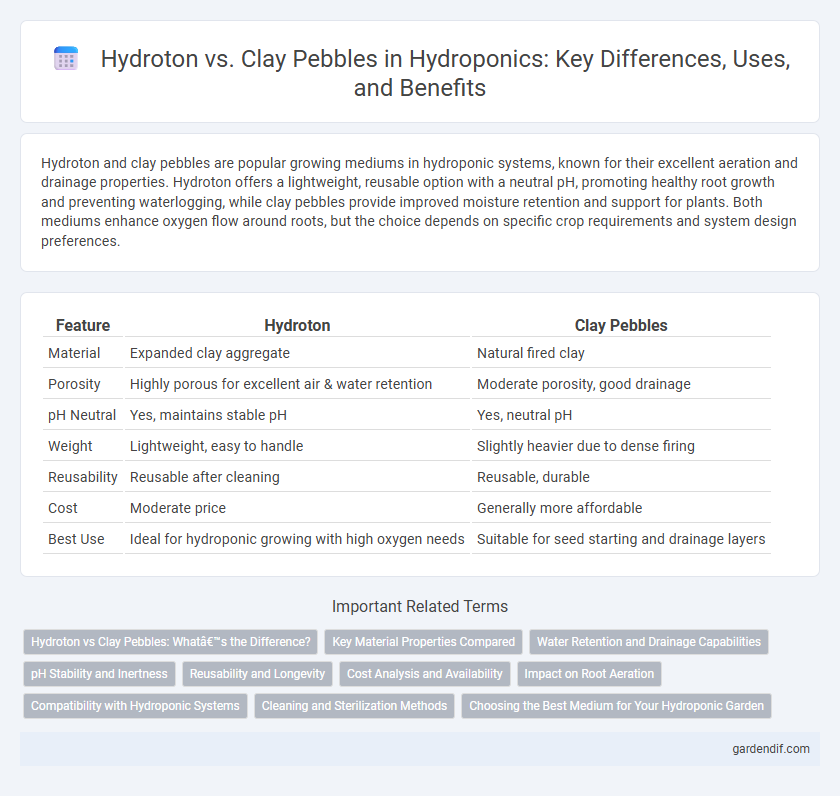
Hydroton vs Clay Pebbles Illustration
Hydroton and clay pebbles are popular growing mediums in hydroponic systems, known for their excellent aeration and drainage properties. Hydroton offers a lightweight, reusable option with a neutral pH, promoting healthy root growth and preventing waterlogging, while clay pebbles provide improved moisture retention and support for plants. Both mediums enhance oxygen flow around roots, but the choice depends on specific crop requirements and system design preferences.
Table of Comparison
| Feature | Hydroton | Clay Pebbles |
|---|---|---|
| Material | Expanded clay aggregate | Natural fired clay |
| Porosity | Highly porous for excellent air & water retention | Moderate porosity, good drainage |
| pH Neutral | Yes, maintains stable pH | Yes, neutral pH |
| Weight | Lightweight, easy to handle | Slightly heavier due to dense firing |
| Reusability | Reusable after cleaning | Reusable, durable |
| Cost | Moderate price | Generally more affordable |
| Best Use | Ideal for hydroponic growing with high oxygen needs | Suitable for seed starting and drainage layers |
Hydroton vs Clay Pebbles: What’s the Difference?
Hydroton and clay pebbles are often used interchangeably in hydroponic systems but differ slightly in manufacturing and performance. Hydroton is a brand of expanded clay aggregate known for its uniform shape, high porosity, and excellent aeration properties, while generic clay pebbles may vary in size and porosity, affecting water retention and oxygen flow. Choosing Hydroton versus standard clay pebbles impacts root development, drainage efficiency, and overall plant health in hydroponic setups.
Key Material Properties Compared
Hydroton and clay pebbles are both lightweight expanded clay aggregates used in hydroponics but differ in porosity and durability, affecting water retention and aeration. Hydroton has a more uniform and less porous structure, providing superior drainage and less water retention, optimal for preventing root rot. Clay pebbles exhibit higher porosity, enhancing moisture retention and beneficial microbial growth, making them suitable for crops requiring consistent hydration.
Water Retention and Drainage Capabilities
Hydroton and clay pebbles both excel in providing excellent aeration, but Hydroton features a porous structure that enhances water retention while maintaining sufficient drainage. Clay pebbles, being denser and less porous, offer superior drainage but lower water retention, making them ideal for fast-draining hydroponic systems. The balance between water retention and drainage in Hydroton supports root oxygenation and nutrient absorption more effectively than traditional clay pebbles.
pH Stability and Inertness
Hydroton and clay pebbles both offer excellent inertness, ensuring they do not alter the nutrient solution's pH levels, maintaining stable conditions in hydroponic systems. Hydroton's expanded clay composition provides consistent buffering capacity, promoting pH stability for extended periods. Clay pebbles are also non-reactive, facilitating optimal root aeration without affecting the solution's pH balance critical for nutrient uptake.
Reusability and Longevity
Hydroton and clay pebbles both offer excellent reusability and longevity in hydroponic systems, with Hydroton typically lasting several years without significant degradation. Clay pebbles maintain structural integrity through repeated use, resisting breakdown and minimizing the need for frequent replacement. Proper cleaning between growth cycles ensures both media types remain hygienic and effective for multiple seasons.
Cost Analysis and Availability
Hydroton clay pebbles are widely available in garden supply stores and online, offering a consistent, lightweight medium for hydroponic systems, but their cost tends to be higher due to manufacturing and shipping factors. Comparatively, plain clay pebbles can be sourced locally at a lower price, yet they may vary in size and quality, potentially affecting plant growth and system efficiency. Cost analysis reveals that while Hydroton requires a greater initial investment, its durability and reusability can offset expenses over multiple growing cycles.
Impact on Root Aeration
Hydroton and clay pebbles both enhance root aeration in hydroponic systems due to their porous structure, but Hydroton typically offers superior oxygen flow because of its lightweight, highly porous composition. The increased surface area of Hydroton promotes better root oxygen exchange compared to standard clay pebbles, which tend to be denser with fewer air pockets. This enhanced aeration supports healthier root development and improved nutrient uptake in hydroponic plants.
Compatibility with Hydroponic Systems
Hydroton and clay pebbles offer excellent compatibility with a wide range of hydroponic systems including ebb and flow, drip, and deep water culture due to their uniform shape and excellent aeration properties. Hydroton's lightweight and reusable characteristics provide durability and stability for hydroponic root zones, promoting optimal nutrient uptake compared to traditional clay pebbles. Both mediums enhance water retention and oxygen flow, but Hydroton tends to maintain structure longer, making it ideal for long-term hydroponic setups.
Cleaning and Sterilization Methods
Hydroton and clay pebbles require thorough cleaning and sterilization to prevent algae and pathogen buildup in hydroponic systems. Hydroton's porous surface demands soaking in hydrogen peroxide or vinegar solutions, followed by rinsing and drying to eliminate trapped debris. Clay pebbles, being less porous, allow easier sterilization using boiling water or bleach solutions, ensuring a hygienic growing medium for nutrient delivery.
Choosing the Best Medium for Your Hydroponic Garden
Hydroton and clay pebbles are both popular hydroponic mediums known for their excellent aeration and drainage properties, essential for healthy root development. Hydroton, made from expanded clay, is lightweight and reusable with a neutral pH, making it ideal for various hydroponic systems such as NFT and deep water culture. Clay pebbles offer superior stability and moisture retention, supporting robust plant growth, and are particularly effective in drip and ebb-and-flow hydroponic setups.
Hydroton vs Clay Pebbles Infographic

 gardendif.com
gardendif.com